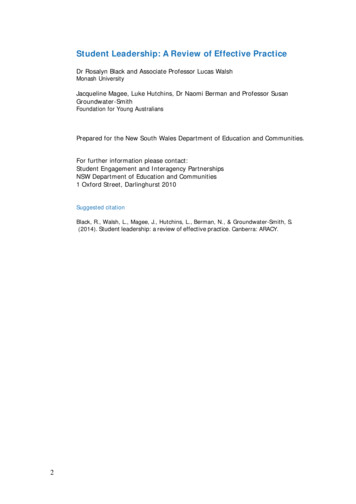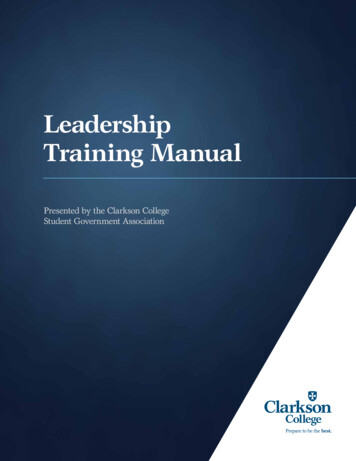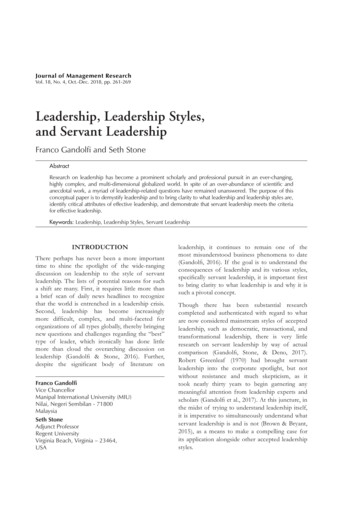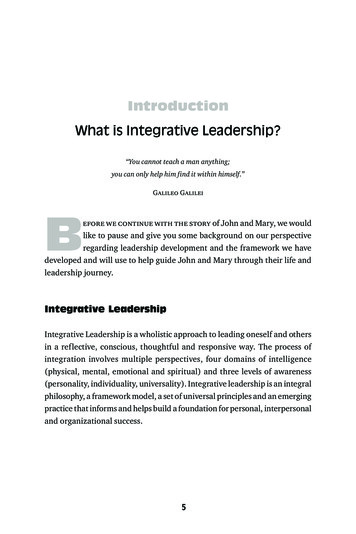
Transcription
Student Leadership: A Review of Effective PracticeDr Rosalyn Black and Associate Professor Lucas WalshMonash UniversityJacqueline Magee, Luke Hutchins, Dr Naomi Berman and Professor SusanGroundwater-SmithFoundation for Young AustraliansPrepared for the New South Wales Department of Education and Communities.For further information please contact:Student Engagement and Interagency PartnershipsNSW Department of Education and Communities1 Oxford Street, Darlinghurst 2010Suggested citationBlack, R., Walsh, L., Magee, J., Hutchins, L., Berman, N., & Groundwater-Smith, S.(2014). Student leadership: a review of effective practice. Canberra: ARACY.2
AcknowledgementsThis What Works for Kids evidence review was the result of a collaborationmanaged by the Australian Research Alliance for Children and Youth withMonash University and the Foundation for Young Australians.ARACY thanks Professor Robyn Broadbent, College of Education, VictoriaUniversity, and Professor Stephen Crump, School of Education, University ofNewcastle for their review of the paper.For further information about What Works for Kids evidence reviews, pleasecontact ARACY:Mail: PO Box 5070, Braddon, ACT 2612 Email: enquiries@aracy.org.au Website:aracy.org.auPhone: 61 2 6248 2400ABN 68 100 902 9213
Table of ContentsStudent Leadership: A Review of Effective Practice . 2Acknowledgements . 3List of tables and figures . 5Executive summary . 6Current theory, policy and practice . 6Enablers and barriers to effective implementation . 9Key findings . 12Introduction . 13Current levels of evidence . 14Definition of terms . 14The practice of student leadership . 17Overview of student leadership policy . 18The international context . 19The Australian context . 21National action . 21State-based action . 23Enabling student leadership . 25Enabling student leadership: policy and systems . 25Enabling student leadership: curriculum, pedagogy and soft skills. 27Curriculum . 27Pedagogy .27Soft skills and literacies . 29Enabling student leadership: the role of community actors 31Evidence of impact on skill development . 32Barriers and challenges to enabling student leadership. 35Policy and system barriers to student leadership .35School-based barriers to student leadership. 39Exclusion from school governance . 39Civics and citizenship curriculum: knowing vs doing . 40Current leadership models: exclusivity and tokenism . 43Compounding exclusion . 44A need for new models . 45The importance of principals and school leaders . 46Principal perspectives on student leadership . 48Best practice and evidence of effectiveness. 48Case study . 52The design of the project . 53Critical moments in the development of students as co- researchers . 552010: PBIS & KERF: A teacher’s response . 554
2011: Observing teachers at work . 562012: Visiting other schools . 562013: The focus for the year. 57Questions of sustainability . 58Case study conclusion . 59Conclusions . 60Enablers and barriers to effective implementation . 61Examples of promising practice . 64References .69Appendix 1: Overview of student leadership initiatives . 85Being Heard . 85Surveys. 86Forums . 86Conferences . 86Advisory positions . 86Multifaceted initiatives . 86Creating Change . 86Student representative bodies. 87Leadership and citizenship activities . 87School change . 87Community change . 87Appendix 2. ‘Being Heard’ – table of program examples. 88Appendix 3. ‘Creating Change’ – table of programs . 92List of tables and figuresFigure 1: Mitra, D. (2006). Pyramid of student voice.Table 1: Opportunities for student leadershipTable 2: Enablers of student leadershipTable 3: Barriers to student leadershipFigure 1: Mitra, D. (2006). Pyramid of student voice.Table 1: Opportunities for student leadershipTable 4: Enablers of student voice: policy and systemsTable 5: Enablers of student voice: curriculumTable 6: Enablers of student voice: pedagogyTable 7: Enablers of student voice: soft skillsTable 8: Enablers of student voice: communityTable 9: Barriers to student leadership: policy and systemsTable 10: Barriers to student leadership: school governance and organisationTable 11: Barriers to student leadership: practiceTable 12: Barriers to student leadership: exclusive leadership modelTable 2: Enablers of student leadershipTable 3: Barriers to student leadershipTable 13: Continuum of student leadership approaches5789101517262931333539404244626366
Executive summaryThis review presents an overview of the existing evidence on the topic ofstudent leadership in educational settings. In addition to a high-level literaturereview of effective interventions, it includes an overview of the broad policyand theoretical trends over the last ten years in both Australian andinternational contexts. Enablers and barriers to the implementation ofeffective practices of student leadership and their implications for Australianschools are identified. A case study is also featured which provides a usefulexample of the various limitations and barriers encountered when applyingstudent leadership practices in the school environment.Current theory, policy and practiceThe concept of student leadership is often used interchangeably with theterms student agency, student voice, and student participation. Researcherstend to identify a spectrum of activities and practices that constitute studentvoice and leadership. For example, Holdsworth has proposed a spectrum ofstudent voice, participation and leadership that ranges from young people“speaking out” to “sharing decision-making (and) implementation of action”(2000, p.358). Fielding has constructed a typology that ranges from youngpeople serving simply as a source of data for school and system processes toacting as active researchers who drive change within their schools (2001),while Mitra’s pyramid of student voice ranges from merely “being heard” to“building capacity for leadership” (2006, p.7, Figure 1).The necessity of participation and freedom of expression is explicitly stated inthe United National Convention on the Rights of the Child, which calls forsignatories to “assure to the child who is capable of forming his or her ownviews the right to express those views freely in all matters affecting the child”(UN General Assembly, 1989). Student leadership practices emerge from thisrights-based concept, reflecting the potential and importance of youngpeople’s capacity to play a role in making the decisions that affect them.As noted in ARACY’s The Nest action agenda, “evidence suggests youngpeople’s participation may have a range of important benefits for theindividual, for organisations and for the broader community” (ARACY, 2014).Specifically within the educational context, participation and decision-makingpractices can afford students with the skills necessary for active participationas engaged citizens.6
Figure 1: Mitra, D. (2006). Pyramid of student voice, from Increasing student voiceand moving toward youth leadership, The Prevention Researcher, 13(1), p. 7.The past two decades have seen a global shift within education policy towardsincorporation of student leadership. Nationally and internationally, policy hasincreasingly expressed the intent to encourage students to take greaterownership of their learning, to play a greater role within the decision makingand change processes of their schools and, ultimately, to have an active rolein the democratic processes and structures of civic society. This reflects thelongstanding recognition that schools are ideal institutions for transmittingsocial norms such as civic leadership and participation and for developing theskills and knowledge required to meet these norms. It also follows alongstanding policy tradition that frames schools as institutions that serve aset of agreed public purposes, including the development of young people’sability to participate as citizens and as leaders in their schools andcommunities.In practice, student leadership can take a number of forms – from classroombased practices through to engaging students as co-researchers or leadership7
of community-level activism. The report outlines the benefits of this broadconceptualisation of student leadership, particularly as the evidence suggeststhat traditional leadership models – such as the Student RepresentativeCouncil – tend only to benefit those who are directly involved, rather thanworking to build the knowledge and skills of all students.Table 1: Opportunities for student leadershipIn the classroom: Encourage students to develop and share their own opinions about currentissues and to engage in debate, discussion and critique of those issues Engage students in conversations and decisions about class rules andbehavioural boundaries and expectations Engage students in conversations and decisions about teaching, learning andassessmentIn the school: Engage students in the governance and decision-making bodies of the school,such as the School Council Engage students as school ambassadors or representatives beyond the school Engage students in peer support, buddying, mentoring or coaching programs Engage students as prefects or in other forms of traditional studentleadership within the school Engage students as members and participants in key school processes suchas staff or school leadership appointment panels Invite and enable students to develop and implement projects to change andimprove school operations, culture, climate or practices Invite and enable students to undertake research and consultation aboutaspects of the school operations, culture, climate or practices that may needchange or improvement Engage students in school change or reform processesIn the school system: Invite and enable students to act as key informants in research processesdesigned to assess or develop school and system practice Invite and enable students to act as key informants in system reformprocessesIn the community:8 Invite and enable students to develop and implement community-basedprojects, possibly in partnership with other agencies, to enhance and supportlearning Invite and enable students to engage with local government and the widercommunity
Enablers and barriers to effective implementationThe review identifies a number of factors that enable effective implementation ofstudent leadership practices in the school environment. The key enablers are to dowith the values and attitudes that underpin leadership cultures and practices in eachschool context. These values and attitudes influence the extent to which studentleadership is considered a priority and the capacity of the school to engageeffectively with student priorities and perspectives. Key enablers include: A belief that schools have a role to play in facilitating and fosteringstudent leadership capabilities, and a belief in the legitimacy and validityof student perspectives. An understanding that there is a spectrum of student leadership and that themost ubiquitous models do not necessarily represent effective or promisingpractice. An understanding of the positive outcomes that can be fostered througheffective practice of student leadership. This will change the perception ofleadership opportunities as no longer ‘supplementary’ to schooling butintegral for student development. School culture, including school management culture, which isaccepting of ‘disruptive’ student leadership influences from theclassroom to the school system and community level. Policy frameworks that enable and promote student leadership.Table 2: Enablers of student leadershipPolicy and systems-level enablers Providing policy frameworks that encourage and support innovative studentleadership practiceEmbedding leadership skill development and civics education in the curriculumCommunicating desired outcomes and ideal practice model/sSupporting information sharing, knowledge exchange and access to research andpractice examplesProviding training, professional development and implementation support to increaseknowledge and foster behaviour changeInvesting in evaluation research and support school-university research partnershipsCommunity enablers Supporting and utilising partnerships between schools and community and other agencies Willingness to example the potential of structured models to promote school-wideleadership practices Supportive environments and opportunities for student leadership outside the schoolcontext.9
Soft skill enablers A curriculum that enables the development of the ‘soft skills’ that underpin leadership A commitment to identifying opportunities for students to engage with social andpolitical issues where it serves the educative purpose and is consistent withcurriculum objectives Supporting the development of leadership skills through ongoing training andcontinuous learningPedagogical enablers Enabling students to make connections between knowing and doing: modeldemocratic processes, learner ownership, student voice and student-centredapproaches Building classroom cultures which encourage participation Providing opportunities for all students to have a voice Encouraging students to explore and debate issuesCurriculum enablers Including civics and citizenship in the curriculum to build knowledge and competencies for student leadership and social participation Explicitly linking student participation in school governance to issues aroundcivics and citizenshipEncouraging leadership through service learning and volunteeringThe barriers to student leadership also include values and attitudes that are notsupportive of student leadership and more expansive conceptualisations of studentvoice, but also include existing systems and structures that inhibit more comprehensivemodels of student leadership.There is also no shared understanding of what ideal models of student leadership looklike, or shared belief about the extent to which schools can or should promote thedevelopment of leadership skills and provide leadership opportunities for all students.Table 3: Barriers to student leadershipPolicy and system barriers Complex and competing priorities, including a potential for theemphasis on standards, performance and accountability to come at the expense ofopportunities to develop student skills more holisticallyLack of consensus about what student leadership is and lack of clarity about idealand most effective form, purpose and outcomesA construction of young people as lacking decision-making capabilityTraditional school hierarchies do not consistently support student leadershipSchool governance barriers 10Students identify a lack of opportunities to participate in school
governance, in spite of a willingness to do so A gap between broader community models of youth engagement and opportunitiesfor participation within schools.Practice barriers Challenges in enacting ‘democratic’ models in practice, including in classroom practice A gap between broader community models of youth engagement andopportunities for participation within schools Teachers do not consistently support student voice initiatives and can resist theintroduction of alternative pedagogical approachesExclusive leadership model barriers 11Current models, particularly the SRC, are inherently exclusive and onlyconfer benefits on a small proportion of studentsSRCs can be dominated and structured by adults, rather than led by studentsSRCs represent one type and form of leadership and may marginalise otherexpressions of leadershipExclusive models of leadership can contribute to and compound the exclusion of moremarginalised students.
Key findingsKey findings and considerations emerging from the review include thefollowing.12 Empowering students to have a discernible impact on their schoolenvironment is an optimal outcome of student leadership. Ideal student leadership models are inclusive rather than exclusive –the benefits of student leadership models accrue only to those whoare directly involved in them. Traditional school leadership structures can be reimagined to promoteinclusivity and encourage participation by marginalised student groups.The most effective programs will be those that foster meaningfulparticipation and experiences by modelling democratic processes andprivileging student contributions in decisions about school governance,policy and pedagogy. Professional training and support for teachers to encourage studentleadership practices and such practices can be embedded withinschool curricula and culture. Rather than viewing student leadership asa threat to traditional teaching practices, classroom teachers canprovide teaching and learning environments in which students areactively encouraged to learn skills that will ready them for activecitizenship and in which those abilities students exercise outside theclassroom are recognised. Community agencies, universities and other organisations can be asource of fresh ideas, models of practice and resources, and canprovide linkages between school and community. Investing in evaluation of existing programs is key to better identifyeffective or promising practice models. There is limited outcomes datafor student leadership practices, therefore limiting ability to assesstheir effectiveness. Further evaluative research of programimplementation is vital to ensure identification of best practice movingforward.
IntroductionThis review of effective practice in student leadership provides an overview ofbroad policy and theoretical approaches in relation to student leadership andincludes an evidence review of effective leadership policy and practice.This report outlines key policy and theoretical trends over the last 10 years,featuring both Australian and international thinking and examples. It also includesa scan of the ideas of student participation, student agency and student voicewhere they relate directly to the core focus of effective practice in studentleadership.Drawing on Australian and international findings, this review discusses theenablers and barriers to the implementation of effective practices of studentleadership and their implications for Australian schools, systems andpolicymakers. The review considers promising initiatives emerging fromEurope and the United Kingdom (UK) and their curriculum focus ondemocratic citizenship practices. Reference is also made to the United States(US) and Canadian systems. The focus of the Australian evidence review is onNew South Wales (NSW), Queensland, South Australia (SA) and Victoria, allstates that have publicly available policy papers and theoretical documentsthat underpin student leadership approaches.Finally, the question of “what works?” is considered, both through atheoretical lens incorporating prominent student leadership and student voicetypologies, and with reference to evaluated initiatives. While formalevaluations of effectiveness are not available for most initiatives, relevantevaluations are discussed in the ‘best practice and evidence of effectiveness’section of this report. An Australian case study is included to illustrate thecomplexity of student participation in aspects of school governance. Theevidence analysed through the review and case study findings indicatesinitiatives that empower students to design their experience of leadershipwithin their school and social contexts have the most meaningful impact.An overview of current practices is included in the Appendices. Appendix 1provides a description of the different types of initiatives and practicesidentified from schools and systems within Australia and internationally. Thepractices are then listed in Appendix 2 and 3, and are grouped according totheir stated aims and descriptions with other like initiatives. Initiatives arepresented under two headings: ‘being heard’ and ‘creating change’.13
Current levels of evidenceThere has been a substantial volume of research conducted in the area ofstudent leadership across Australia and internationally over the last severaldecades. The concept of student voice became prominent in the 1960s andhas persevered, fostering a range of student leadership initiatives both withinand outside of schools (Mager & Nowak, 2012, p. 39). While there is anemerging body of literature on student leadership, and student leadershipstructures in the majority of schools, there is very little robust evidence ofpolicy and program effectiveness. Other significant gaps in the literatureinclude the immediate and longer-term impact of leadership opportunities onskill development, learning outcomes, workforce participation or ongoing civicparticipation; youth perspectives on leadership; and the types of approachesand strategies for strengthening leadership that are the most effective.The majority of literature drawn on for this report is grey literature or smallscale studies with limited sample sizes. More rigorous forms of research, suchas longitudinal or quasi-experimental studies, were not identified in thisreview, and where program evaluations are available, they tend to be processevaluations grounded in qualitative data. These yield useful findings andenable the identification of common themes and emerging better practiceexamples, but without studies that measure impact and outcomes, firmconclusions about ‘what works’ are challenging.Definition of termsDespite growing policy efforts designed to foster student leadership, there islittle consensus about what the terminology ‘student leadership’ actuallydenotes, the purposes it should serve, how it should be fostered or evenhow it should be named (Black, 2012). Instead, a range of other terms suchas ‘student voice’, ‘student participation’, ‘active citizenship’ and ‘democraticschooling’ are all used within the literature, often interchangeably with‘student leadership’. To inform analysis of what works in student leadership,this high level review included policy and research documents, grey literatureand evaluations made public. Given the multiple and often ambiguousdefinitions attached to the term student leadership, ‘student voice’ and‘student agency’ were also included as search terms.Some theorists have attempted to bring greater clarity to this field byformulating typologies or models of student voice, participation, agency andleadership. These frequently distinguish between forms of activity that aredeemed to be in the student’s own interest and those that are not, betweenforms that are designed to inspire change in the student’s experience andthose that are not, and between forms that enable or require the14
transformation of school practice and those that support the pedagogicalstatus quo (Black, 2012). Hart’s ‘Ladder of Participation’ (1992) is the bestknown and most widely cited of these typologies, but others are also useful.For example, Holdsworth has proposed a spectrum of student voice,participation and leadership that ranges from young people “speaking out” to“sharing decision-making (and) implementation of action” (2000, p.358).Fielding has constructed a typology that ranges from young people servingsimply as a source of data for school and system processes to acting as activeresearchers who drive change within their schools (2001). Mitra’s pyramid ofstudent voice ranges from merely “being heard” to “building capacity forleadership” (2006, p.7, Figure 1). As these typologies suggest, the purposesand outcomes for which student voice, participation and leadership arefostered remain extremely varied.Figure 1: Mitra, D. (2006). Pyramid of student voice, from Increasing student voiceand moving toward youth leadership, The Prevention Researcher, 13(1), p. 7.Internationally, one of the best-established arguments links young people’sopportunities for participation to their human rights. The 1989 Convention onthe Rights of the Child was seminal in establishing the right of children andyoung people to such actions as freedom of thought, freedom of expression,15
and the right to an education that will “encourage responsible citizenship”(United Nations, 1989). As Lansdown notes, the impact of the Convention hasbeen so considerable that “for many people, children’s rights have becomesynonymous with participation” (2010, p.11).There are many other definitions and interpretations, however, includingthose that link student voice, participation and leadership to the improvementof schooling and society. A large body of literature, for example, advocatesstudents’ active role within school decision-making as a means of informingschool reform and restructuring processes including improvements topedagogy, curriculum and assessment (see, for example, Fielding, 2001;Mitra, 2003). It describes the benefits which accrue from studentscontributing to whole-school decision-making processes as well as theircapacity to co-create curricula with their teachers and to shape the nature ofthe learning occurring in the classroom (Ruddock & Flutter, 2004).An equally extensive literature positions student participation as aprecondition for greater student engagement in learning, recommending thatschools “allow students to become active participants in their education,including involvement in decisions about what and how they learn, and howtheir learning is assessed” (Department of Education and Early ChildhoodDevelopment, 2009, p.10). This literature suggests that the experience ofparticipation gives students a stronger sense of membership within the schooland a stronger sense of themselves as learners (McInerney, 2009). Inparticular, it advocates participation and leadership as a means of improvingthe
student leadership practices in the school environment. The key enablers are to do with the values and attitudes that underpin leadership cultures and practices in each school context. These values and attitudes influence the extent to which student leadership is considered a priority and the capacity of the school to engage










